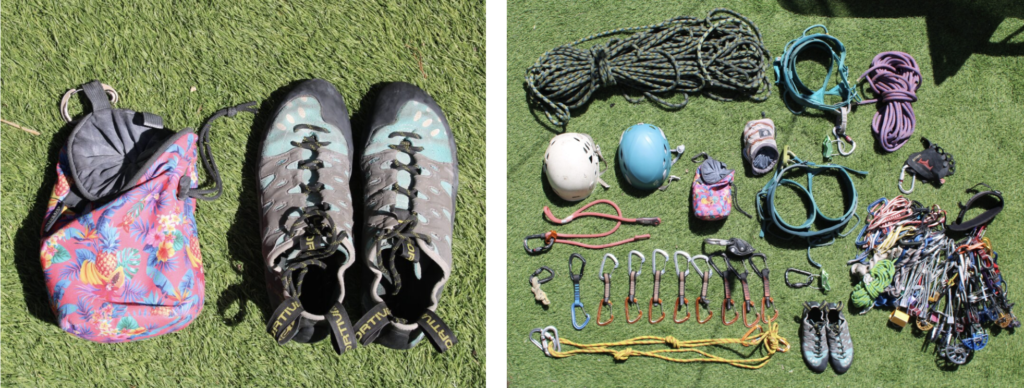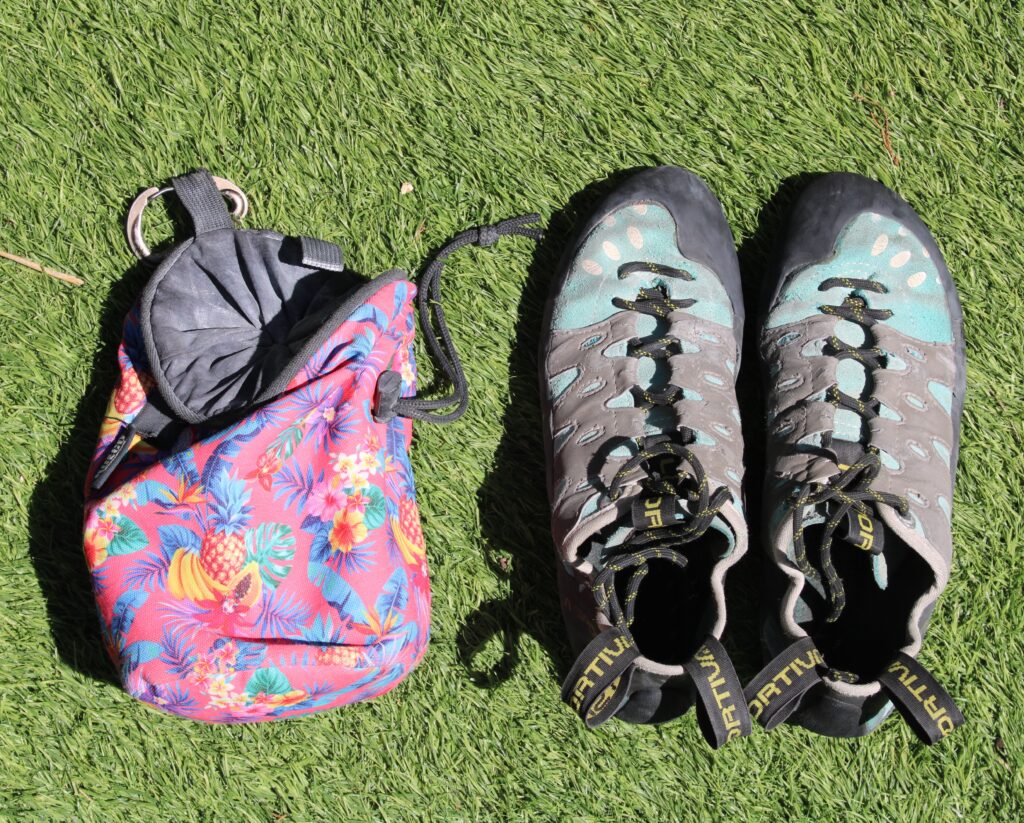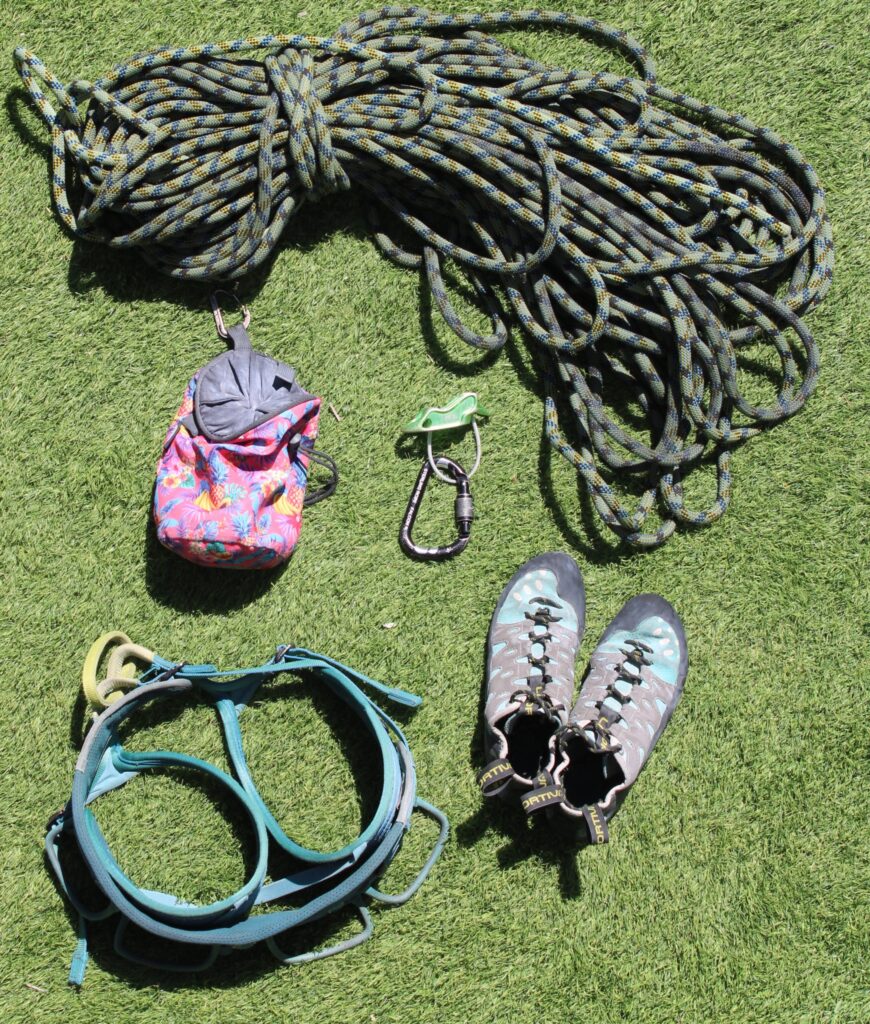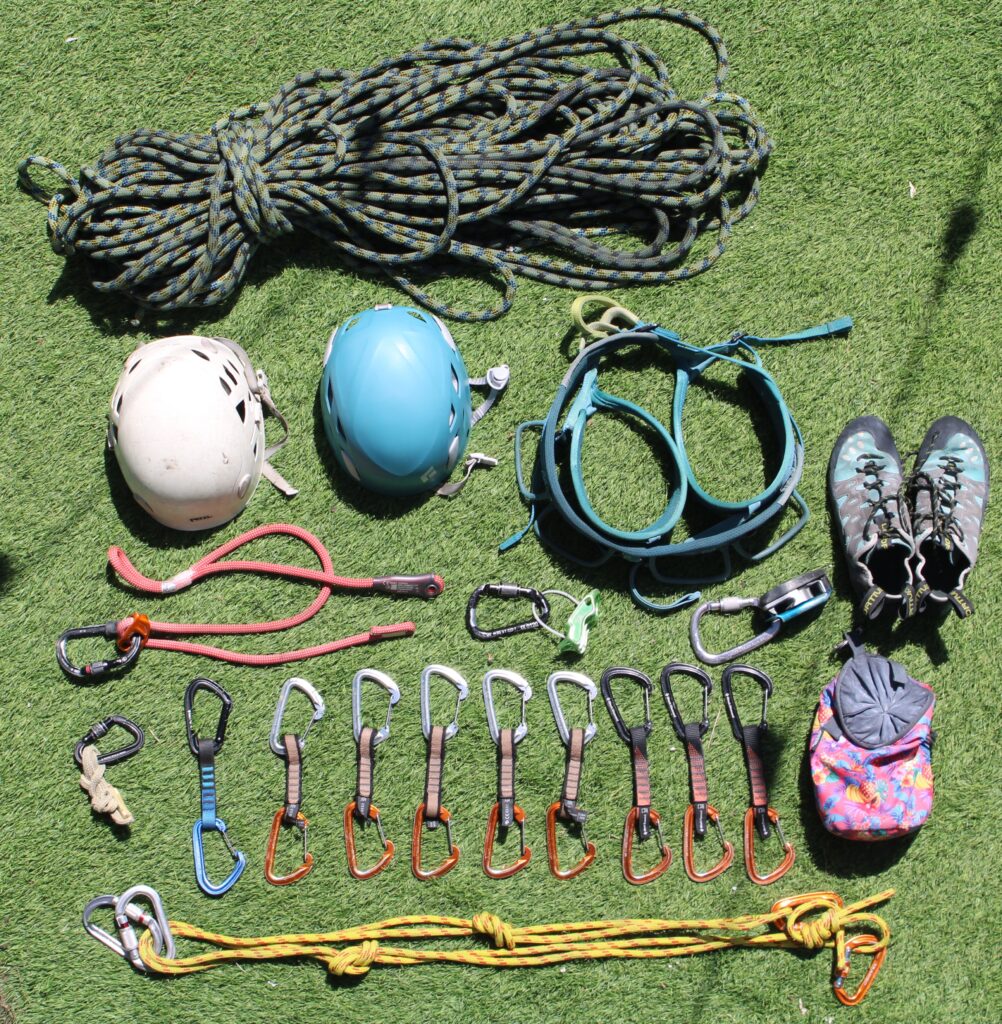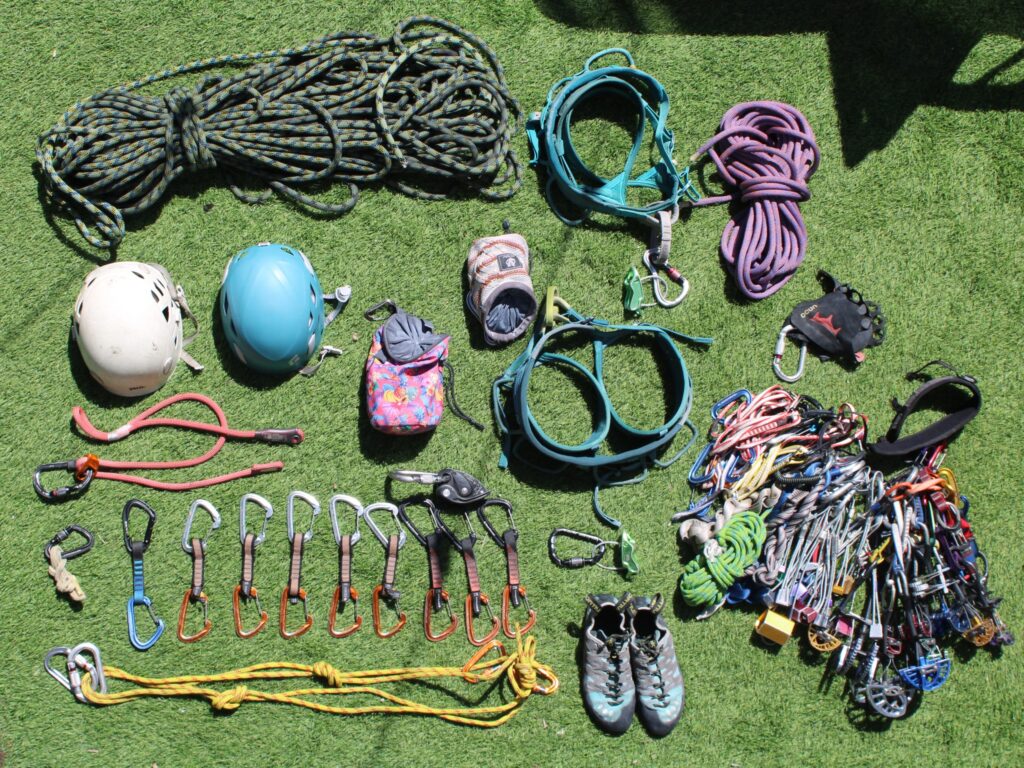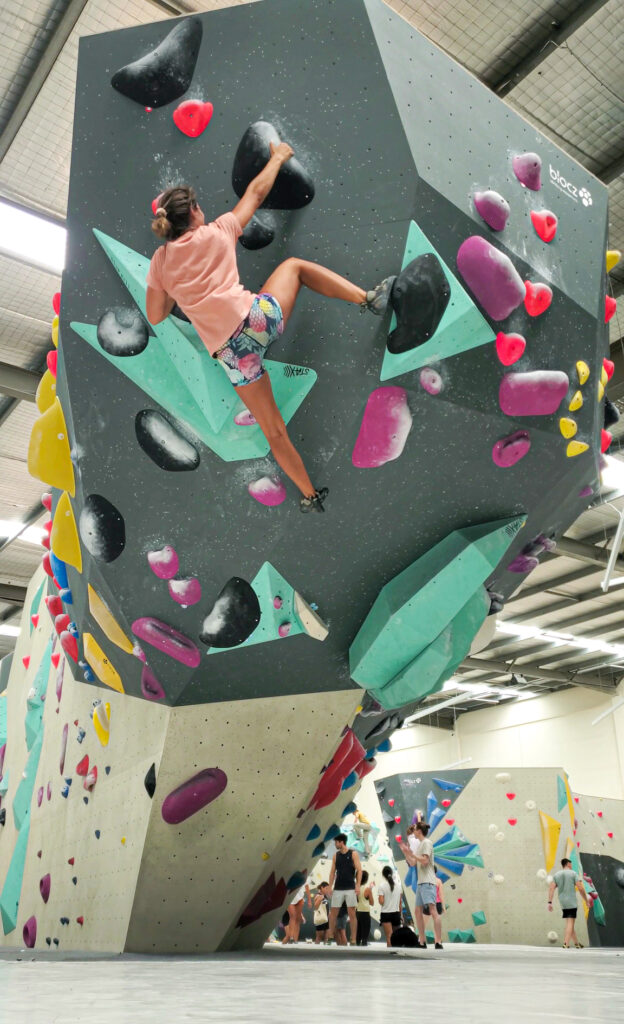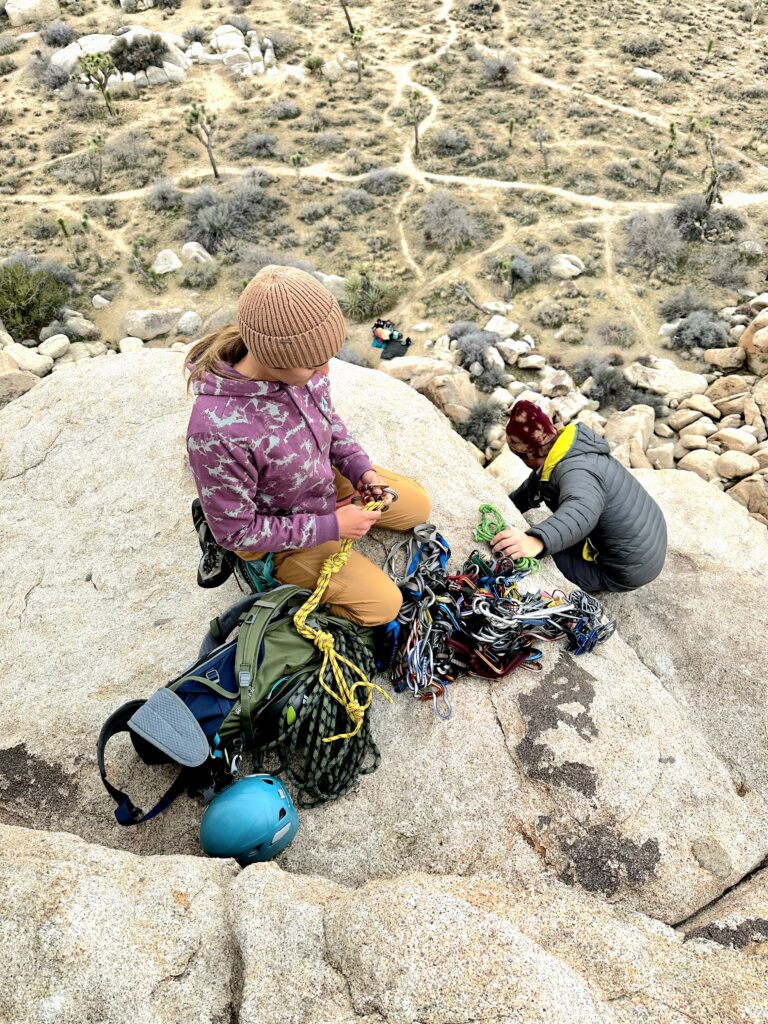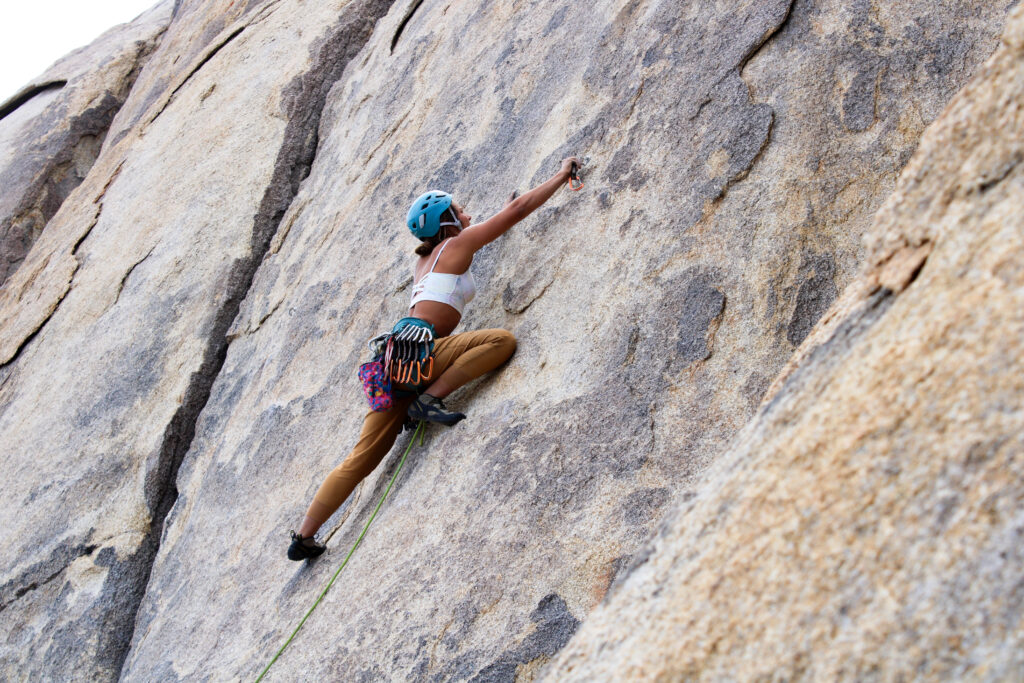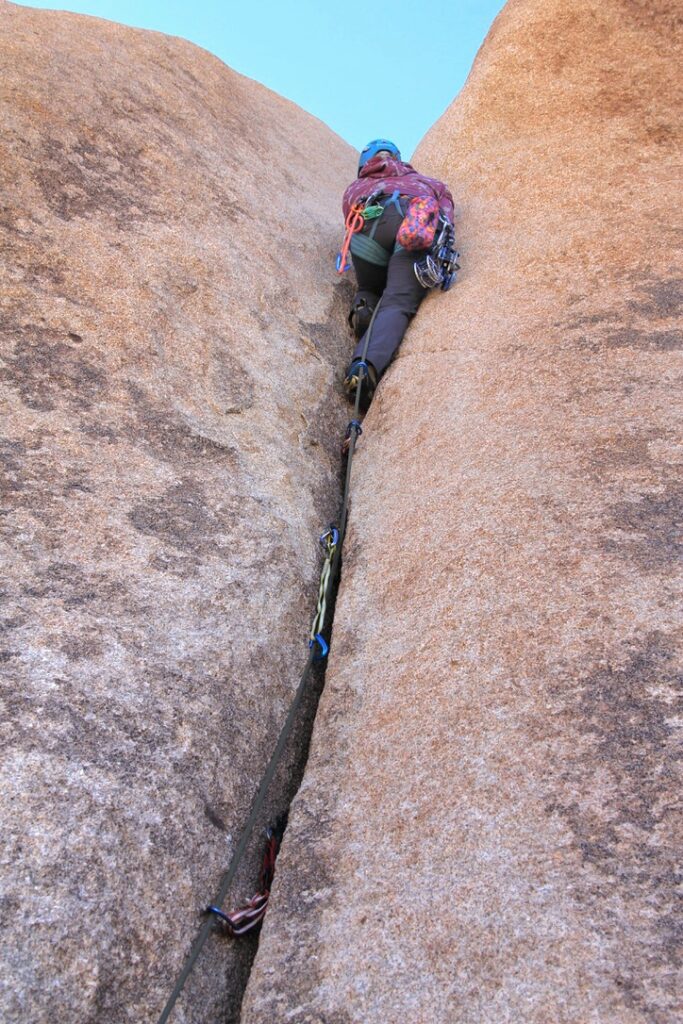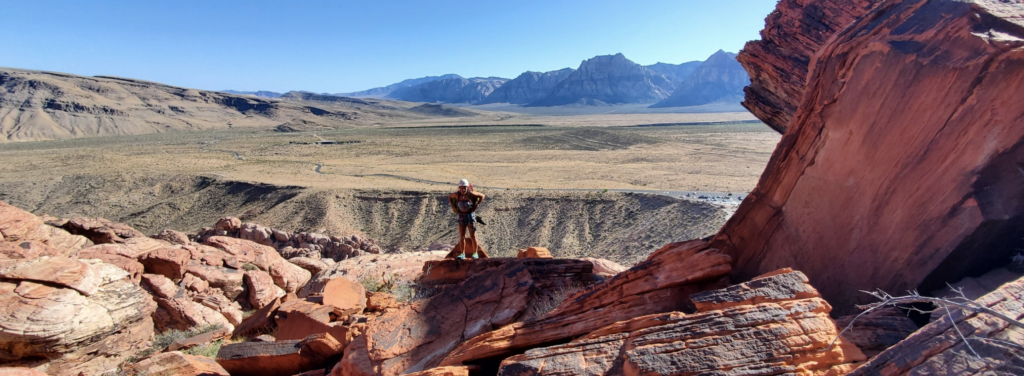Even as an experienced climber, rock climbing is a fairly affordable sport. We don’t need expensive bikes or lift tickets to participate. Once you invest in gear, it lasts a long time.
Personally, the cost of rock climbing has accumulated slowly over time as I’ve progressed through the disciplines. Now that I’m set up, I only have to pay for fuel and accommodation on most climbing trips.
Luckily, with some friends living in convenient places, sometimes I only pay for fuel! I highly recommend making friends.
As a beginner, the initial cost of rock climbing is much less. However, getting into rock climbing might seem altogether daunting. The sport itself seems gear intensive and downright terrifying.
As you look more into it, you realize that there is a list of disciplines all requiring different gear and skillsets: bouldering, top-rope, sport, traditional, mixed, ice, indoor, outdoor, single pitch, multi-pitch, alpine, big wall. It’s hard to know where to begin, what gear to buy first, or even what to wear.
I personally find it hard to invest in expensive gear if I’m still not sure about the sport itself.
In this guide, I’ll break down the cost of rock climbing from indoor bouldering through outdoor traditional multi-pitch climbing. I’ll also provide links to the gear I personally use. Even though each climber has their own personal preferences, I hope to help you prioritize which direction to go so you can invest in gear you actually need right away.
Disclaimer: Some of the links in this article are affiliate links, designed to allow The Unremarkable Climber (me) to earn a small commission if you choose to make a purchase through them, at no extra cost to you. This really helps support the site and lets me know you find this information valuable! That being said, all of my gear recommendations, commission based or not, are genuine recommendations for gear I personally use, so I hope you love them as much as I have! Feel free to drop any questions in the message box below.
Cost of Rock Climbing: Easy Comparison
Below I’ve compared the total cost of rock climbing by discipline based on the estimated price of new gear. Obviously, different brands vary and you could definitely find some of this secondhand, but buying new is generally the safest bet until you know how to inspect secondhand gear.
The only exceptions would be shoes and a crash pad. If you’re cool with wearing used climbing shoes, you can potentially save a lot of money.
Each category is broken down further with additional tips!
Cost of Rock Climbing Indoors
For one day: $40
- day pass
- rentals
For one year: $950 – $1150
- Gear: $150
- Gym Membership: $800 – $1100
The cost of indoor rock climbing becomes pricey if you go consistently. Luckily, you don’t have to commit to anything right away!
For one day: $80
- day pass
- belay class
- rentals
For one year: $1000 – $1500
- Gear: $200*
- climbing shoes
- harness
- belay device
- chalk bag
- chalk
- Belay class: varies
- Gym membership: $800 – $1100
*The best deal I can find for a new harness, chalk bag (including chalk), and belay device (including locking carabiner) is this package from REI which is only $100 and also available in a men’s version.
For one year: $1200 – $1700
- Gear: $300 – $400
- shoes
- harness
- belay device
- chalk bag
- chalk
- 40m-60m** dynamic climbing rope
- Belay classes: $50 – $150
- Gym membership: $800 – $1100
*The best deal I can find for a new harness, chalk bag (including chalk), and belay device (including locking carabiner) is this package from REI which is only $100 and also available in a men’s version.
**A 40m will be long enough for most indoor gyms, but if you are looking to transition outside, you will need a 60m for most outdoor climbs.
I calculated indoor rock climbing price by researching the day rate and membership prices of climbing gyms around Los Angeles. Gyms near you may vary.
Most climbing gyms rent gear and give day passes, so you technically don’t have to invest in any gear up front to try it out, but that adds up over time.
I found that most offer discount punchcards if you plan on going a few times per month. However, if you plan to go more than once a week, an annual membership is the best deal.
I found it challenging to calculate the cost of rock climbing indoors because climbing gym rates vary so much.
Not only do climbing gyms vary in price, but also in gear required, so search around for the best deal. Some provide belay devices, and others require you to bring your own.
Occasionally, belay classes are included with a day pass or membership, but most cost more. The cost of lead climbing classes ranges from $40 to $140.
Even yearly memberships range from $800 to $1100! I’d recommend trying out a few gyms (if you have the ability) and find one that works for you.
Cost of Rock Climbing Outdoors
Cost of Outdoor Bouldering Gear: $350
This is the cost of rock climbing with new gear. If you buy used shoes and a used crash pad, the total cost would be close to $200.
There are two ways to go about top-roping outside:
#1 Show up at the crag with your own gear, make friends, and offer to belay: $200
You’ll need:
- my all-time favorite climbing shoes!
- harness
- belay device
- chalk bag
- chalk
- positive attitude
*The best deal I can find for a new harness, chalk bag (including chalk), and belay device (including locking carabiner) is this package from REI which is only $100 and also available in a men’s version.
#2 Find a partner who has their own gear and invest in all of your own gear: $500
You’ll need all of the above plus:
- 60m – 70m rope (depending on your local crag)
- Anchor building supplies
If you do decide to top-rope outside, be sure to find a knowledgeable friend or local course to teach you anchor building, cleaning, and rappelling in addition to doing your own research. A high percentage of climbing deaths happen while cleaning anchors and rappelling, not while climbing.
Cost of sport climbing outside: $700
- my all-time favorite climbing shoes!
- harness
- belay device
- helmet
- chalk bag
- chalk
- 60m – 70m rope (depending on your local crag)
- Anchor building supplies
- 10+ quickdraws (depending on the climb**)
- Optional 2nd anchor setup for multi-pitch: $65
If you do decide to sport climb outside, be sure to find a knowledgeable friend or local course to teach you proper leading technique, proper lead belaying technique, anchor building, cleaning, and rappelling in addition to doing your own research. It is critical to know how to lead and lead belay properly to reduce the risk of injury or death. Someone’s life is literally in your hands.
*The best deal I can find for a new harness, chalk bag (including chalk), and belay device (including locking carabiner) is this package from REI which is only $100 and also available in a men’s version.
**Single-pitch sport climbs require anywhere from 2 to 17 quickdraws. Additionally, you may choose to use two quickdraws as the anchor if the fixed gear safely permits it, plus an extra in case you drop one, but you’ll always need a full anchor as a back-up if you aren’t familiar with the area.
Estimated cost of traditional climbing outside: $1875
- my all-time favorite climbing shoes!
- harness
- belay device
- helmet
- chalk bag
- chalk
- 60m – 70m rope (depending on your local crag)
- Auto-block recommended
- 10+ quickdraws
- Anchor building supplies
- 30-50ft cordalette
- 4+ locking carabiners
- Personal anchor system + two locking carabiners
- Standard trad rack: $1175 ***
- 10+ alpine draws of varied length: $300
- Cams up to #3: $750
- Set of nuts: $125
- Optional 2nd anchor setup for multi-pitch: $65
- Optional 2nd rope for rappelling longer multi-pitch routes: $150
I would advise against learning traditional climbing from a friend. This is really something you should learn from an experienced guide because a small mistake can lead to a fatal injury. I’d recommend a course like this 2- Day Anchoring Course offered by Vertical Adventures.
*** This standard trad rack will get you by in most places, but every crag is different. Find the gear that works best with your local rock type. For example, I frequently use a set of tricams in Red Rock, NV and really rely on my offset nuts when climbing in Joshua Tree, CA. If you plan to climb splitter cracks, focus on doubles or triples of a few cam sizes.
As I suspected, the cost of rock climbing outdoors is less than paying to go to a rock climbing gym if you consider the lifetime of the gear, but the risk is also higher if you’re not confident with the gear.
Unless you know competent climbing friends, I’d recommend starting in the gym and taking a few classes with a local guiding service. Not only will you learn how to safely work with the gear, but you’ll most likely make friends who are more experienced than you and can teach you a thing or two!
However, be careful with who you trust, and take friends’ advice with a grain of salt. Hiring an experienced guide to teach you is always the best course of action.
Indoor Bouldering vs. Rock Climbing
Now that rock climbing has made its Olympic debut, there is growing interest in the sport. Most of us have been indoor rock climbing as a kid at some point, but as adults, most of us don’t know much about the disciplines.
I am always getting asked to compare bouldering vs. rock climbing. I find it a bit silly because bouldering is one of many types of rock climbing!
Indoor rock climbing is comprised of both unroped and roped climbing. Bouldering is an unroped form of rock climbing while top-rope, lead climbing, and speed climbing all require ropes.
What is Bouldering?
Bouldering is a type of unroped rock climbing on walls up to 15 feet high over a padded surface. Despite being short, boulders require incredible power and coordination.
In the United States, boulders are rated with the V grading system with the easiest at V0 and most challenging at V17, though climbing gyms rarely exceed V10.
Bouldering in a gym is potentially the easiest discipline to get started in. It requires the least gear and therefore the lowest initial investment. Most gyms rent gear and offer day passes, so there’s no commitment to start.
Roped Climbing: Top-Rope vs. Lead Climbing
Both top-rope and lead climbing are types of rock climbing using ropes on walls over 15 feet tall. Both types of climbing require a belayer—a person that attaches in to the other end of the rope.
Your belayer manages your rope as you climb and catches your falls using a belay device.
Additionally, some rock climbing gyms have auto belay systems that replace the belayer in a top-rope setting by taking in the slack as you climb and slowly lowering you when you fall or reach the top.
Top-Rope Climbing Explained
Top-rope climbing is a type of roped climbing where you tie into a rope that runs from you to the top of the climb and back down to the belayer. The belayer takes in slack as you climb.
This is probably the safest form of climbing as long as you have a competent belayer. If you do fall off, you generally only fall a foot or so.
Speed Climbing: A Fairly New Discipline
Speed climbing is a type of timed top-rope climbing up a standardized climbing route using an auto belay system. Featured in the Olympics, this discipline is growing in popularity.
What is Lead Climbing?
Unlike top-rope climbing, lead climbing has a greater risk of big falls. The rope runs straight from the belayer to you and you must clip your rope into quickdraws every five to ten feet as you climb.
Therefore, the belayer must be very attentive as they feed you slack in the rope, and must be prepared to catch a big fall. If you fall, you are caught by the last carabiner you clipped.
Consequently, lead climbing indoors can result in falls upwards of 15-20 feet.
Outdoor Rock Climbing Explained
As the Olympics have brought popularity to indoor rock climbing, outdoor rock climbing has been thrust into the limelight by documentaries like Free Solo and The Dawn Wall.
Similar to indoor climbing, outdoor climbing has both roped and unroped disciplines. Actually, the indoor styles of climbing translate well to real rock. However, the gear management is much more involved, especially as the walls become cliffs which become mountains.
The cost of rock climbing outdoors might be less than indoors over time, but the real cost comes in the increased risk.
Outdoor Bouldering
Similar to indoor bouldering, outdoor bouldering is a type of unroped rock climbing on relatively short walls.
However, the walls can be much taller outdoors. Some “highball” boulders stand 50 feet tall, and could be considered more of a free solo as a fall would be deadly. Most are much shorter, but because you must bring your own pads, the climbs are a bit riskier.
The ground is often uneven and, unlike in the gym, climbing over the top is often the most challenging part.
However, bouldering outside is free and allows you to spend time in nature which is something a climbing gym just cannot replicate!
Outdoor bouldering is easily the most accessible style of climbing because it’s relatively inexpensive and you don’t need a partner (though a spotter is definitely a plus). If you have access to boulders nearby, it’s a great way to improve quickly without having to rely on others or learn much about complicated gear.
Outdoor Roped Climbing: Top-Rope vs. Lead Climbing
Just like indoors, both top-rope and lead climbing outdoors are types of rock climbing using ropes on walls over 15 feet tall and require a belayer. Additionally, outdoor roped climbing requires anchor-building and increased risk-management skills.
Whether you choose to top-rope or lead, you should be confident in safely using your gear in different scenarios because a mistake can be fatal. The types of outdoor lead climbing begin to differ in the gear required to protect yourself from a fall.
Top-Rope Climbing Explained
There are two ways to top-rope outside.
The first is to meet up with a group that is knowledgable in the local area and competent enough to utilize their gear safely. Many crags require lead climbing to reach the top and set a top-rope anchor.
Finding friends who can lead is the cheapest way to start climbing because more experienced climbers will already have most of the gear. It’s relatively easy to find groups that meet up to climb outside via social media or your local climbing gym, but showing up to a popular crag on a weekend and offering to belay is a good way to make friends too!
However, be skeptical of new climbing friends. Just because someone can climb well doesn’t mean they can safely set an anchor.
Another option for outdoor top-roping is to find a belayer and a crag where you can walk up to the top to set an anchor yourself without having to lead the climb. If you choose to go this route, be sure you are competent with anchor-building, cleaning, and rappelling, as well as the gear involved before heading out.
Lead Climbing Outdoors: Trad vs. Sport Climbing
Lead climbing outdoors is similar to lead climbing indoors overall, but there are a few key differences.
In a climbing gym, you can clip the gear that’s already there, but outdoors, you have to place the gear into the wall prior to clipping in your rope. Additionally, outdoor climbs usually won’t have clips at the top to easily clip into and lower.
The best method for coming down depends on what you find when you reach the top of the climb. This often depends on the style of climb.
So, what’s the difference between trad vs. sport climbing?
What is Sport Climbing?
Sport climbing is the most similar to indoor lead climbing. However, on a sport climb, there are already bolts in the wall, but you must clip a quickdraw into the bolt before clipping your rope in.
Occasionally, you’ll find fixed gear called mussey hooks at the top of the climb to clip into and lower (like many climbs at Malibu Creek), but often you’ll only find rings or chains so you’ll have to rappel the route.
What is Trad Climbing?
Traditional (trad) climbing is a step up from sport climbing. You still lead the climb, but instead of fixed bolts in the wall, you have to place your own protection (like cams and nuts) into cracks. This type of lead climbing is much more time consuming and highly gear intensive (and expensive), but very rewarding.
I highly recommend learning from an experienced guide because placing protection properly will literally save your life. Additionally, many trad climbs will not have any fixed gear including anchor bolts, so you’ll have to walk off the top and hike back down to the base to avoid leaving expensive gear behind.
What is Multi-Pitch Climbing?
All of the styles of roped climbing I’ve described so far have been single-pitch climbing, which means you climb up to the length of your rope and then come down. Multi-pitch climbing is when you reach the anchor, belay your partner up to you, and keep going up! Multi-pitch climbing can be done in both sport and trad climbing styles.
Hooked on Rock Climbing?
Now that you know a little bit about the cost of rock climbing and the various disciplines, here are a few other posts that can help you get started!
Subscribe below to be the first to read upcoming posts like:
The Santa Barbara Rock Climbing Trifecta
The Ultimate Channel Islands Camping Trip: A 7-Day National Park Epoche

